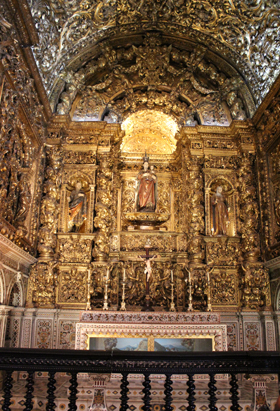 Portugal is one of the “hottest” European vacation destinations right now. Its increasing popularity is based on its great value, mild year-round climate, and is also fueled by its incredible diversity. Alongside a depth of arts and culture, Portugal is blessed with a wide variety of beautiful landscapes. Snow-capped mountains, rolling plains, breathtaking coastline, exotic Atlantic Islands and jet-setting beach resorts all await you. Visitors also discover the wine and cuisine of Portugal that has been often overlooked. As well as the famous Port, expect fabulous red and white wines produced in the country’s several wine regions, delicious cuisine including exceptional seafood and heavenly pastries – all at very affordable prices.
Portugal is one of the “hottest” European vacation destinations right now. Its increasing popularity is based on its great value, mild year-round climate, and is also fueled by its incredible diversity. Alongside a depth of arts and culture, Portugal is blessed with a wide variety of beautiful landscapes. Snow-capped mountains, rolling plains, breathtaking coastline, exotic Atlantic Islands and jet-setting beach resorts all await you. Visitors also discover the wine and cuisine of Portugal that has been often overlooked. As well as the famous Port, expect fabulous red and white wines produced in the country’s several wine regions, delicious cuisine including exceptional seafood and heavenly pastries – all at very affordable prices.
No matter where you go in Portugal you will find history, museums, arts and music - coupled with beautiful cities, monuments, gardens, religious buildings and more. Portugal has no less than 19 UNESCO World Heritage sites. These treasures reflect the variety and cultural richness of Portugal itself and range from monumental buildings, historic quarters and architectural sites to stunningly beautiful landscapes.
You will find everything from Pre Roman pottery to the religious architecture of the Sephardic times when synagogues, mosques and churches stood together in peaceful coexistence. And from the explosion of music, art and learning during the Renaissance to today’s hub of modern artistic expression in all forms.
Portugal is the most easterly point in Continental Europe – and in the fifteenth century Portugal was right on the edge of the known world. It is from here that brave navigators headed off into the unknown to discover the “new world”. As a result, the capital Lisbon is a gracious city, packed with history and with its face decidedly turned towards the Atlantic Ocean.
Mainland Portugal is divided from West to East by its main river, the Tagus, that flows from Spain and disgorges in the Tagus Estuary, in Lisbon, before escaping into the Atlantic. The northern landscape is mountainous towards the interior with several plateaux indented by river valleys, whereas the south, which includes the Algarve and the Alentejo regions, is characterized by rolling plains. Visitors will enjoy the distinct landscapes and culture of the different regions of Portugal, as well it’s island territories of Madeira and the Azores.
It has never been easier to get to Portugal and there are some great fares available and a great choice of airlines. Flight time is around 6 hours with direct flights from Canada. TAP Portugal now fly five times a week direct from Toronto to Lisbon with onward connections to Porto, Faro (Algarve), Madeira and the Azores. Air Canada fly to Lisbon and Porto from Toronto and to Lisbon from Montreal. And Transat fly seasonally to Lisbon, Porto and Faro in the Algarve.
No wonder Portugal is one of the most popular tourist destinations in the world! It is affordable, accessible and packed with everything that travellers enjoy – culture, history, mouth-watering cuisine and some of Europe’s finest wines together with wonderful beaches and spectacular scenery.
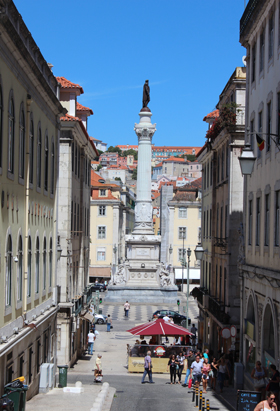
Lisbon is an elegant city built on seven hills where the Tagus River meets the Atlantic Ocean. The old parts of the city are formed by steep, narrow cobbled streets that are filled with cafes, restaurants and boutique shops. During the 18th century disaster struck Lisbon when an earthquake, tsunami and subsequent fire destroyed many parts of the city. However, the city was rebuilt with wide and gracious boulevards and elegant squares, so today’s Lisbon is a wonderfully walkable city to explore.
Here are some of the highlights of a visit to Lisbon:
Lisbon Architecture
The Belem Tower is a UNESCO world heritage site and one of Portugal’s most famous monuments. The Gothic tower was built to guard the entrance to the harbour and has some fine examples of Portuguese stonework dating from the 1500’s.
The Mosteiro dos Jerónimos, also known as the Monastery of St. Jerome or the Jerónimos Monastery, is a UNESCO World Heritage site located in Lisbon's Belém district. Exemplifying Portugal's Manueline style …..Tourists can also stop by the Chapel of St. Jerome and the tombs, which contain notable Portuguese people in history including a handful of royals and Vasco de Gama himself.
Portugal's first king, Afonso Henriques, laid the foundation stone for The Church of St Vincent 'Outside' - that is, beyond the then city walls – barely a month after taking Lisbon from the Moors in 1147. The big draw is the cloisters, richly decorated with early 18th-century tile panels.
Castelo de São Jorge, or St. George's Castle, is perched atop Lisbon's highest hill in the Alfama district, offering both excellent history and views of the city. The castle served as a fortification for the Romans, Visigoths and the Moors, who turned it into a royal palace before it was eventually taken by Portugal's first king, Afonso Henriques.
Sao Roque Church - the church with the plainest façade in Lisbon - has one of the city's richest interiors. Each of the chapels is a masterpiece of Baroque art - the showpiece is known as the "world's most expensive chapel." Designed in Rome using the most costly materials available, including ivory, agate, porphyry, lapis lazuli, gold and silver, it was blessed by the Pope and shipped to Lisbon in 1747.
Lisbon Museums
National Tile Museum - One of the most notable aspects of Lisbon's alluring architecture is its vibrant ceramic tiles. The museum is filled with tiles of all colours and sizes, some of which date back to the 15th century. It is housed in the monastic buildings of the Madre de Deus Convent. Renovated after the Great Earthquake it has one of the most magnificent interiors in the city.
The Berardo Museum of Modern and contemporary art has one of the world's most acclaimed modern art collections, with works by Warhol, Picasso, Dali, Duchamp, Magritte, Miró, Bacon, Jackson Pollock, Jeff Koons, among others representing dozens of modern movements. It is housed in a space inside Lisbon's Belem Cultural Centre.
Portugal's national gallery, the Ancient Art Museum, contains 14th to 20th century European works by artists such as Bosch (whose "Temptation of St. Anthony" is one of the museum's most valuable treasures), Dürer, and Raphael.
Maritime Museum - The interesting Maritime Museum is one of the most important in Europe, and celebrates Portugal's domination of the seas. 17,000 items are installed in the west wing of Jeronimos Monastery, and include model ships from the Age of Discovery onward. The oldest exhibit is a wooden figure representing the Archangel Raphael that accompanied Vasco da Gama on his voyage to India.
Other Lisbon Attractions
The Oceanarium is Portugal's largest indoor aquarium, holding more than one million gallons of seawater supporting the lives of 8,000 sea creatures.
If you're searching for a unique souvenir to take back home, you might want to try your luck at the Feira da Ladra flea market. Located in the Alfama district and spread out across Campo de Santa Clara, the contents of Feira da Ladra can be trash or treasure!
Get an idea of its layout and all things to do in Lisbon from the top of the Aqueduto das Águas Livres – the city’s majestic aqueduct, erected in the 18th century under King John V.
For some sweeping views of Lisbon – particularly St. George's Castle, Rossio Square and the Baixa neighborhood – you might want to take a ride on the Elevador de Santa Justa. Designed by Raoul Mesnier du Ponsard (a former student of Gustave Eiffel – creator of the Eiffel tower), this neo-Gothic elevator is more than a century old and used to be powered by steam.
Tram 28 - Some tourists choose to take Tram 28 through the Alfama neighbourhood because it's so hilly - but however you get there a visit to the picturesque Alfama is a must. With a history that dates back to the Moors, Alfama is characterized by narrow, cobblestone streets that wind past dozens of quaint shops, cozy little restaurants and traditional Fado clubs. Fado is a unique form traditional Portuguese singing, characterised by haunting, sad songs about lost love and heartbreak.
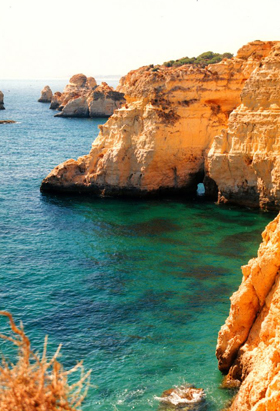
The Algarve
The southernmost region of Portugal is the Algarve. This is the most visited part of Portugal, and a haven for sun seekers from all over the world. It is world famous for its excellent beaches. Long days with non-stop sunshine make the Algarve a great alternative to the Caribbean any time of year.
The climate in the south of Portugal is particularly benign in the spring – from March until May is a great time to visit. The average high temperature climbs to 18ºC in March, 20ºC in April and 22ºC in May. Long stay vacations in the Canadian winter are particularly attractive - and snowbirds seeking an extended vacation enjoy special rates with incentives for stays of multiple weeks. Hotels that cater to long stays and apartment style accommodation are readily available.
Southern Portugal abounds with quaint fishing villages, walled historic centres, beaches dotted with spectacular rock formations, and winding streets lined with colourful tiled buildings. For a dose of adventure, explore the Algarve’s intriguing grottoes by boat, or ride the challenging waves of the Atlantic.
The Alentejo
The Alentejo region is bounded by the Algarve to the South and the River Tagus to the north. It is bordered by Spain to the east and to the west it is bathed by the Atlantic Ocean. Representing a third of the whole of continental Portugal, it is a thinly populated, rural region. The beauty of its landscapes is matched by the scope of its archaeological, architectural and cultural heritage. The Alentejo is also well known for its gastronomy and excellent wines.
The UNESCO World Heritage Site of Évora is a highlight of any visit to the region. In the 15th century it became the residence of the Portuguese kings. In just one city you can visit many treasures such as a Roman Temple, the Cathedral of Santa Maria, the Palace of King D. Manuel, the Mirador-Terrace of the Casa Cordovil, the Manueline Window of the Casa de Garcia da Resende, the Colégio do Espírito Santo, now part of Évora University, Praça do Giraldo (the main square) and the Teatro Garcia de Resende.
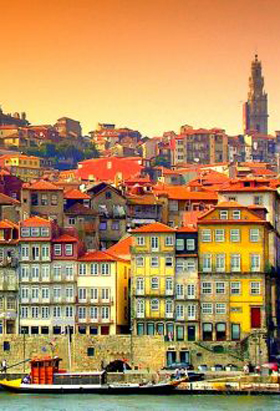 Central Portugal
Central Portugal
Central Portugal is the very heart of the country and extends from the Tagus River north towards Port and the Douro Valley. The region has many unforgettable sights. Aveiro is known as the “Portuguese Venice”, and is quietly dominated by the Ria de Aveiro, described as “a living body that connects the land to the sea like a huge heart.” Coimbra is where the grave of Kings Afonso Henriques and Sancho I, the first Portuguese Kings lie - and all over the city you will discover landmarks left by those who built the nation, including the great University, created by King D. Dinis.
Fatima has become one of the key centers for the Cult of the Virgin Mary in Portugal and has been recognised world-wide by the Catholic Church. The town of Batalha developed alongside the Monastery of Santa Maria de Vitória and was constructed in 1386. It kept a vow by Portuguese King Dom João I to the Virgin Mary that he would build it if Portugal defeated Castile at the Battle of Aljubarrota in 1385. Another treasure is Obidos - encircled by a ring of medieval walls and crowned by a Moorish castle that was rebuilt by King D. Dinis. It is one of the most perfect examples of a medieval fortress you will find anywhere in Europe. Since it is a Pousada, so you can stay in this magnificent building - Pousadas provide hotel accommodation in historic or scenic properties throughout Portugal.
Northern Portugal
The northern wine growing region of Portugal brings you fabulous Duoro valley wines, and of course the Port wine is made in Porto. The historic centre of Porto and the River Douro where the Port Wine lodges are located, are classified as World Heritage. As well as the River Douro and its heritage on both banks, discover bridges and monuments, buildings with beautiful blue and white azulejos tiles and flower laden balconies - and excellent shopping streets.
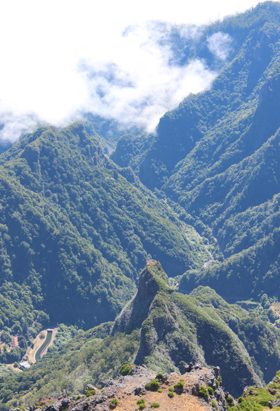 The archipelagos of Madeira and the Azores are scattered across the Atlantic Ocean. Geologically, these islands were formed by volcanic and seismic events. Historically, Madeira was the first landfall for the pioneering navigators of the 15th Century and Portugal’s first colonial acquisition.
The archipelagos of Madeira and the Azores are scattered across the Atlantic Ocean. Geologically, these islands were formed by volcanic and seismic events. Historically, Madeira was the first landfall for the pioneering navigators of the 15th Century and Portugal’s first colonial acquisition.
Madeira
Nowadays, Madeira is just a 90 minute flight from Lisbon. It is blessed with spectacular cliffs and scenery and is a haven of peace and relaxation. H N Coleridge, nephew of the poet, waxed lyrical after a visit in 1825: “I should think the situation of Madeira the most enviable on the whole earth. It ensures every European comfort with almost every tropical luxury.”
Nature is all around you in Madeira, and it is increasingly popular to get out on the water to look for dolphins and whales. The island is almost a living Geography textbook. Thrust up out of the Atlantic Ocean by volcanic action less than 1 million years ago, this young island has been subjected to only limited erosion. The cliffs that fall sheer into the ocean are the highest in Europe and the mountain peaks soar to over 6,000 feet in the centre of the island with breathtaking views.
Clouds build up against the mountains in the north of the island, and this is where most of the rainfall occurs. Six centuries ago the people of Madeira started building a unique irrigation system – the levadas – which still operate today and account for the lush vegetation and fresh produce grown throughout the island. The levada water channels were built by hand and usually a shaded path runs beside the chattering water. Today’s visitors are able to take advantage of a huge range of trails and everyone from casual walkers to serious hikers can find walks to enjoy.
The Azores
The Azores are nine magnificent islands just five hours direct flight from Canada. Each has a unique character and there is much scope for “island hopping” by boat or plane during your stay:
- Sao Miguel - the largest island – displays its volcanic origins in the crater lake of Sete Cidades and the Fogo Lagoons. The power that emanates from the earth is felt in the geysers, hot thermal waters and volcanic lakes, as well as in the tasty "Cozido das Furnas" slowly cooked inside the earth.
- Santa Maria has beaches of warm white sand and the vineyards covering the slopes like an amphitheatre resemble giant staircases.
- Terceira features the World Heritage town of Angra do Heroísmo, as well as its festivals, and is steeped in history.
- Graciosa is classified by UNESCO as a World Biosphere Reserve and is the northernmost of the five islands that make up the central group of the Azores archipelago.
- Sao Jorge’s highlights are the characteristic Fajãs - created from collapsing cliffs or lava flows – that extend into the sea.
- Graciosa, graceful in both name and appearance, is an island of green fields covered with vineyards that contrast with its peculiar windmills.
- Pico is Portugal’s highest mountain that emerges from the sea, with vineyards planted in black lava fields, with a unique culture that has World Heritage status.
- Faial is the cool blue of the hydrangeas, with a busy marina visited by yachtsmen from all over the world. The extinct Capelinhos volcano resembles a lunar landscape.
- Flores has the beauty of the natural waterfalls and the lakes carved out by volcanoes are dazzling.
- Finally, the tiny island of Corvo has a broad, beautiful crater at its centre, and attracts many species of birds coming from both Europe and America
Want to know more about the destination? Check out Chris' Travel Notes!
Chris writes extensive Travel Notes for each show that will help you plan your next trip. Find out more about the Destination; Climate; Getting Around; Accommodation; Kids to Seniors; History; Sports and Activities; Attractions; Culture; Cuisine; Special Deals and where to go to get even more information!
Click on the Travel Notes icon to download a pdf file that you can read, print out and even take with you on your travels! |
|